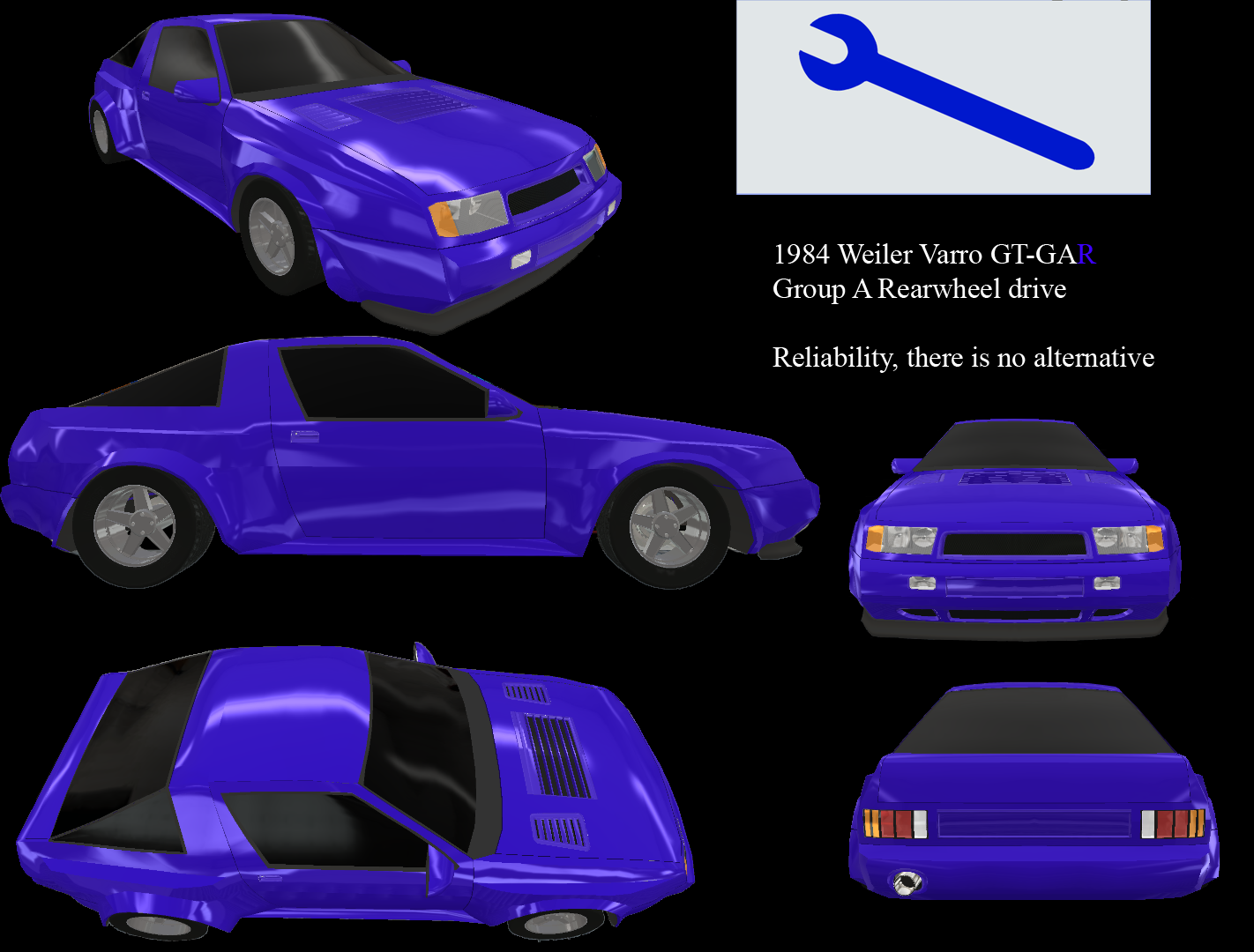Okay, it's hopefully submitted so...here you all go with the car story and the finalized car.
I wish I could have just made this picture a bit more presentable but...I guess I'll do better another time.
1984 Weiler Varro GT-GAR - Group A Rearwheel drive

- Weiler Varro Group A.png (522.46 KiB) Viewed 5569 times
--Recovery from hardship, a springboard back into the big time.
While Weiler was able to rely on their utility and commercial vehicles to survive the oil crisis of the 70s, in addition able to make all purpose customer cars including it's first generation Meshar GT Hatchback as a more 'economical' take on things (alongside future proofing it's Hardy 2 door machine among others), the company was at work with a new car as a flagship into their future endeavors to fully recovery from the mid to late 1970s.
The company had a difficult time enough staying in higher profile motorsports in light of the oil crisis', even in spite of their beforehand 'future proofing' of their entire lineup, and legitimate racing successes, they were lucky to still hang on strong with their touring car and GTP/Group C endeavors as direct factory efforts. Indycar now being a secondary and they were currently out of Formula 1, as the Cosworth DFV proved too good a motor for any of their efforts for now.
They saw Group A as one more chance to get back into more of a winning streak, or at least if nothing else, make a popular car to be modified by customers, and willingness to give factory and semi-factory support, alongside their Group B efforts, including a final sendoff of their first gen Meshar.
At the 1983 New york Auto show, came the debut of the Varro. Just before that very motor show, after it, and before the road cars themselves hit the dealerships in early 1984, various test mules of various engine, suspension, drive-train and even chassis configurations were used, 25 in total until they could settle on specific setups that were easily adaptable across all their models to specified purposes. Those 25 mules had later been preserved, with a few as machines among the higher ups in the company, and select customers.
As for the 6 prototypes used for Group A, 3 for rallying, 3 for circuits, and then switched to see how each performed out of their element, they all used the AR/AV-4 25 block, first started in the 1970s, this engine served as their workhorse for their sedans, hatchbacks and sport coupes as standard, the parts changed according to the situation while the engine block displacement remained unchanged.
Extensive testing both in engineering and actual road testing made them come up with a very specific configuration. Called the AR4-25-84-A , this engine was built to go with group A specifications, but retained being reliable, even economical to a small degree (at least better than a Dodge Aspen), Although not to the extent of their other cars. However when seeing their competition perform...they put their cards on the table to see what other options could and could not be explored.
The initial rules for group A only allowed turbocharged motors up to 2 liters, while the AR-25 had several turbo configurations, it was too big an engine to be turbocharged and still be legal for Group A Homologation, and the company was hesitant to use smaller blocks based off it given their mixed fortunes with turbocharged engined in the past at 2 and under liters. In addition, the VA6-28, An SOHC V6 a motor specific to Group A's max allowed NA limit, was still in development and not yet regarded as reliable enough, and the same went for the AO5-20 and 28 models, an Inline 5 that still had issues with balancing and smoothness.
Attempting to enlarge the engine to 2.8L yielded unsatisfactory results, and an Inline 6 was a too long horizontally. They then tried to use a smaller take on their abandoned V8 from Formula 1 and found that while it was powerful, it was for their purposes, a little too heavy for their goals then and there.
So the engineers decided to simply stick to the company's policy of a reliable machine, sticking with the AR/AV4, tweaking ignition timing and fuel mixture among other features. Their goal was just 200bhp and over 18mpg (US).
Which was met along with making the car 'bare bones' enough to be changed accordingly to what a racing customer would want with it, but also make it liveable and reliable.
While it retains many of the features that would be present in the road cars, due to the specified rules, a choice had to be made between either removing the wing or front lip, and it was decided to keep the front lip. One other change was replacing the rear suspension, the concept and standard production machines, a semi-trailing arm, with a solid axle leaf rear suspension with the purpose of making it more worthy of off-roading alongside making it higher and a less-stiff suspension in that regard.
Finally, a change in ventilation on the roof. The original concept had a 200+bhp turbo motor using mechanical fuel injection developed in-house. This NA motor with a carb 4 barrel configuration, had an altered central vent, with additional vents to assist with hot air extraction and cooling, in addition to an attempt for a cleaner aero profile.
The whole package in total including 4 seats weighed a slim 2024 pounds, and an overall price just over $8000 US (adjusted for inflation, $18,252.83 in 2015 money), it exceeded safety requirements and overall, a car meant to be very drivable but compromised on comfort and prestige. In return it had a low maintenance cost total of a little over $1300.
With this configuration finalized, the first 2500 models to be assembled at the factory were built to this specification. The remaining that year, were built to the finalized road model specifics, and during all this, plans were already in motion to build both rear drive, and all wheel drive variants, both for Group A, and eventually Group B alongside the Meshar.
With this start, Weiler were on their way to become a prominent motorsport force once more even if their overall manufacturing capacity was at best, 2/3rds of any of the largest car companies at that time.









